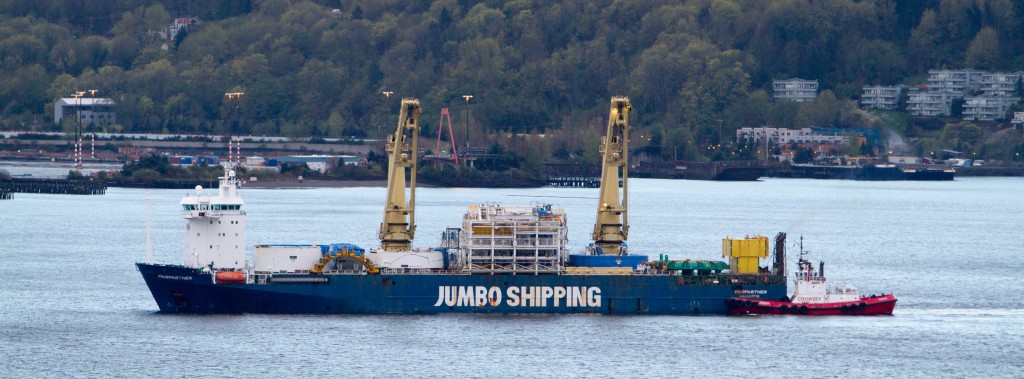
Bertha, the massive highway tunnel boring machine, is stuck in one place underground until at least next March. The future of State Route 99 has moved firmly into uncharted territory, so I thought I’d start a discussion of what might happen next.
First, a recap.
After the 2001 Nisqually quake damaged the SR-99 viaduct, the state legislature started seriously considering funding for a replacement. In 2003, they passed the “Nickel” funding package, providing $177 million in funding to begin design work and start buying right of way. In 2005, once the general scope of the replacement became clear, the Transportation Partnership Program provided $2 billion toward construction.
In 2006, voters in Seattle were asked in an advisory vote to choose between a ‘cut and cover’ tunnel or a replacement elevated structure, and rejected both.
Even at that point, there was a surface boulevard option that put money into transit and downtown street grid improvements, much like San Francisco’s Embarcadero, and would have torn down the damaged viaduct immediately; nearly every party involved ignored that option, other than the project’s citizen advisory committee, which endorsed it.
Also in 2006, the state asked Sound Transit to delay their “Sound Transit 2” vote until 2007 to pair it with a regional highway expansion vote which would have included additional funding for the SR-99 project. Sound Transit did so, and in November, the “Roads and Transit” measure failed, preventing even more money from going to the project. Sound Transit went back to the ballot in 2008 and passed handily.
Finally, in 2009, the state proposed a bored tunnel–the largest in the world–to replace the freeway. They capped the total state spending on the project at $2.4 billion, and assigned responsibility to the city if the project went overbudget. A referendum on the city council’s agreement with the state failed in 2010, and the Washington State Department of Transportation (WSDOT) started construction.
Since then, the expensive machine has broken, as predicted by many, while other highway infrastructure deteriorates, sometimes spectacularly, and maintenance remains underfunded across the state. The viaduct, touted after 2001 as dangerously unsafe, remains standing, despite a 2008 promise from then-governor Gregoire that it would be torn down in 2012.
The first failure in this project was that it went past the drawing board.
Great. Now what?
I’m going to gloss over the mess of Bertha’s failure: the machine’s bearings failed, causing it to overheat when it spun the cutting head. The contractor has a plan that they believe could get the machine digging by March of 2015. To do this, they’re digging a pit down to the front of the machine, planning to pull off the 57-foot wide cutting head, replace the bearings inside the machine, and make a whole host of improvements to try to keep the machine from breaking again.
First, and soonest, as they dig a pit in wet muck between Elliott Bay and the existing viaduct, they’re going to have to pump water out of it–what they call “dewatering”. When you pump water out of the ground, the ground tends to sink.
Sunk
Sadly, this isn’t as fun as actually sending the viaduct to the bottom of the ocean. The viaduct is only considered safe to drive on (if you can consider it safe at all) as long as it doesn’t sink more than an inch, and at least one part of it sank 4/10 of an inch when tunneling began.
WSDOT never planned to dewater in the area where Bertha is stuck now, so it’s likely the viaduct will sink further. If it hits that full inch, it’ll have to be closed to traffic. At that point, we’ll see adaptation–traffic will worsen in the short term, transit use will spike, and the region will reach a new traffic equilibrium over a few weeks as people take other routes and change their habits.
It’s very likely that traffic Downtown would improve as a result of tens of thousands fewer cars. It’s entirely possible that once the viaduct is closed for a couple of months, we’d see political will to throw more money at a new freeway disappear–and maybe WSDOT could even sue the contractor for damages to cover the cost of a new surface boulevard and transit improvements.
Torqued
If the viaduct stays afloat and repairs are completed successfully, we come to another potential point of failure. One theory for Bertha’s failure is that because of its size, the pressure against the bottom of the cutting head is much higher than the pressure against the top, torquing it against the bearings and causing them to wear quickly. I understand this is one of the points the repair is supposed to address, but as it’s being done by the same company that claimed the machine was fine in the first place, I don’t have high hopes.
If the bearings are damaged again, and the machine goes twice as far this time as it did the first time, it would end somewhere under Downtown–either under 1st Ave or an adjacent building. At that point, perhaps under the Four Seasons hotel or one of the buildings of Pike Place Market, a repair would have to be attempted from inside the tunnel; and be more costly and time-consuming than the current year-long repair plan.
Lawyered
On the legal front, a source close to the project tells me that WSDOT has rejected a “change order” from the contractor to increase the contract amount by the amount of the repairs, indicating that the state believes the contractor is responsible. If the contractor disagrees, they may stop work arbitrarily, or only work until they run out of money. At that point, WSDOT might have to sue the contractor to complete the project (or even the repairs).
This is only one of several ways the project could end up in court–and given the history of Ron Tutor of Tutor Perini, 45% of the “Seattle Tunnel Partners” joint venture, it seems likely.
Unplugged
While there are oodles of other ways this project can still die, there’s one more that I find particularly interesting.
This project came from former Governor Gregoire, then-state Senator Ed Murray, former mayor Greg Nickels, county executive Dow Constantine, and most of the current Seattle City Council. All of them are Democrats in a state with only a small Democratic majority. If the tunneling isn’t complete or cancelled by the beginning of the 2016 election season, I expect the Republicans to campaign against Governor Jay Inslee on the cost and Seattle focus of the project.
With that in mind, if I were Inslee, I would be looking for a way out, and I’m sure his team isn’t blind to this risk. If the viaduct sinks, the money runs out, or the machine fails again, I expect to see him and WSDOT pull the plug.
What can we do?
This project may not die, but if it can, the best things we can do to help it along are small.
First, tell every local elected official you meet that you want this tunnel dead, that you’ll vote against any highway money, and that you’ll donate to candidates who oppose highways and build transit and high speed rail instead.
Oppose highways every chance you get. There are a dozen more projects like this one in the pipelines of state departments of transportation across the country. A lot of them are stalling due to a convergence of the interests of anti-tax and pro-sustainability voters. People need to hear in casual conversation that highways are dangerous and unhealthy, a past mistake we must remove and correct.
Tell Seattle City Council candidates that you want them to oppose highways, full stop. When you find one that does, give them a check if you can, and go doorbell for them. If you live in the 6th, for instance, you’re all set.
Finally, be ready for the next legislative session. Come January, we’ll need to testify against highways and for transit. When you come to Olympia in-person, your voice carries.


